Cussy-en-Morvan to Saulieu
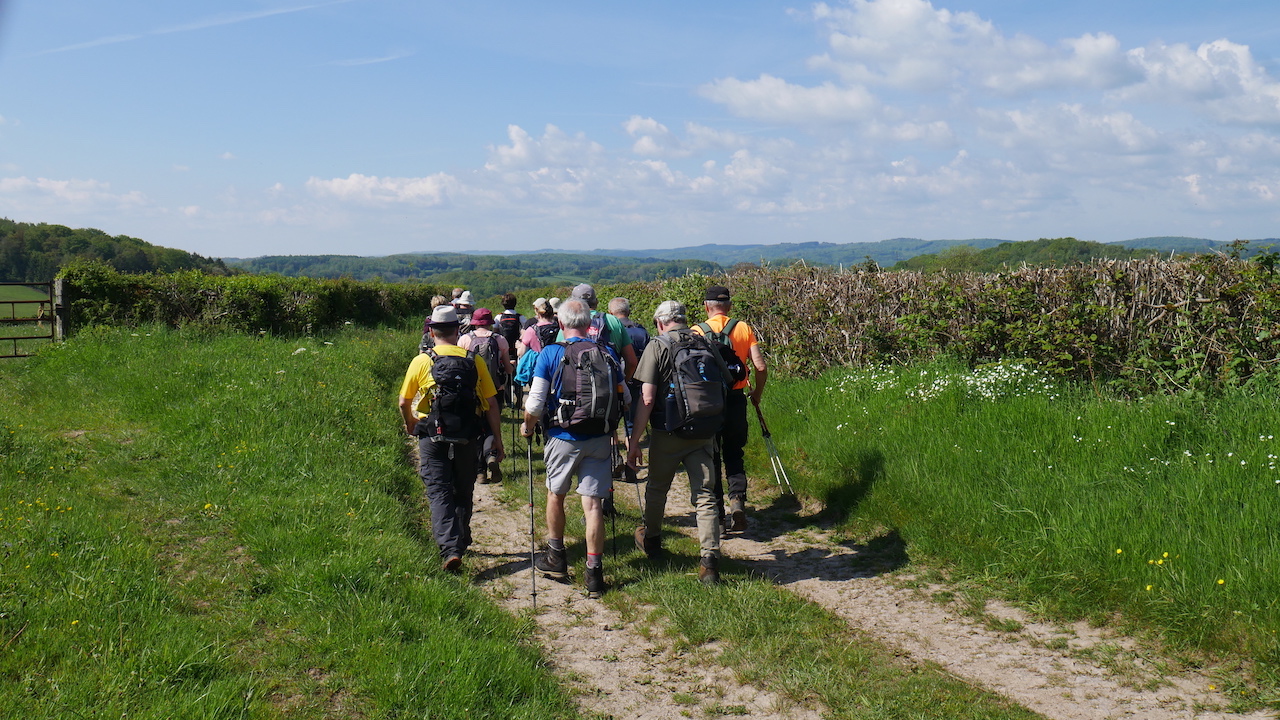
Bourgogne-Franche-Comté
14. Cussy-en-Morvan to Saulieu
Difficult
7h30
29,2km
+756m
-695m
Step
Embed this item to access it offline
You will walk among the hedgerows of pastures tended by cattle breeders. These hedgerows are also a reservoir of fauna and flora that you should observe during a break. The villages you pass through welcome you and invite you to discover their natural heritage and their churches. Observe the horizon to discover beautiful residences.
From Moux-en-Morvan you are in the land of the Christmas tree, the main production of the Nièvre.
Finish your stopover in Saulieu, capital of gastronomy, which has a very eclectic heritage.
From Moux-en-Morvan you are in the land of the Christmas tree, the main production of the Nièvre.
Finish your stopover in Saulieu, capital of gastronomy, which has a very eclectic heritage.
8 points of interest

Le Bourg de Cussy-en-Morvan - Amis saint Colomban TouristChurch of Saint Peter and Saint Paul in Cussy-en-Morvan
Dedicated in the past to Saint-Léger (today Saint-Pierre and Saint-Paul), the time of its construction is not known but it is mentioned as early as the 10th century: the bell tower of Cussy was one of the five bell towers making up the Marquisate of Roussillon, it was the highest of all the surrounding parishes. The choir and the two side chapels are said to date from the 15th century; the nave, flanked by two side aisles, was rebuilt in 1851; the two bells were rebuilt in 1858 by Auguste Hildebrand, founder of his majesty the Emperor. Seven statues from the 15th to 17th centuries, classified or inscribed as historical monuments, and two liturgical pools from the 16th century, also historical monuments, can be admired.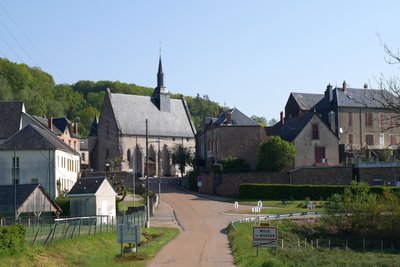
Le village de Moux-en-Morvan - Amis saint Colomban TouristSaint-Denis Church in Moux-en-Morvan
The parish church of Moux-en-Morvan is under the name of Saint-Denis, it is of Renaissance style and dates from the 16th century. There are traces of a first church in Moux-en-Morvan, around 1530, the church was rebuilt in 1830 with the addition of a sacristy (flat roof), the building is rectangular in plan, its buttresses are projecting. The campanile bell tower is central, it is covered with slates, its spire is fine. It has paintings from 1895 by the painter Bodin (the baptism of Jesus, Saint Christopher, patron saint of travellers, carries Christ on his shoulder, the Holy Family Joseph the carpenter and Mary). The body of the church is pierced with Gothic style windows. The portal is simple. A stair turret allows access to the attic. It is registered in the Inventory of Historic Monuments on March 27, 1986.
Église Saint-Hilaire d’Alligny-en-Morvan - Amis saint Colomban TouristSaint-Hilaire Church in Alligny-en-Morvan
This parish is mentioned in an 8th century text and in 1380 the old church was on the left bank of the river Ternin. The present church was probably the seigneurial chapel of which the 12th century bell tower remains, decorated with geminated bays and columns with capitals. In the 15th century, Lord J. de Fontette had a square choir built, vaulted in warheads, and restored the north and south chapels. In the 19th century, the nave was replaced and the aisles were extended. A major restoration was carried out between 1960 and 1980.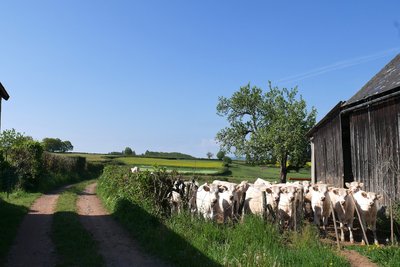
Génisses charolaises élevage à Alligny-en-Morvan - Amis saint Colomban PanoramicIn the Morvan: sustainable agriculture
In France, Regional Nature Parks have the possibility to sign regional productions, services or know-how with a logo owned by the Ministry of the Environment and Sustainable Development. This logo "Product of the Morvan Regional Nature Park" indicates that the products and services concerned are the result of activities that respect the three values of the Regional Nature Parks: preserved environment, human dimension, and living territory, through a global approach of the signatory companies.
Raising cattle for meat is a traditional activity in the Morvan, drawing on the know-how of the breeders who practise it. The animals are born, raised and fattened on the territory of the Park. The pastures must be located in the Park (location of the grassy areas necessary for feeding up to 75% of the territory). The animals are of meat breeds, mainly Charolais, Limousin and Blonde d'Aquitaine breeds of cattle.
More information : Morvan Park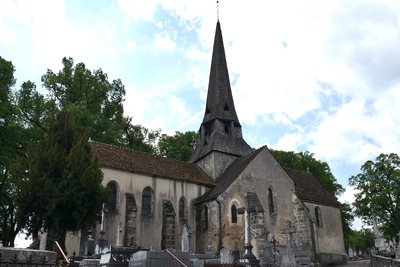
Église Saint-Saturnin à Saulieu - Amis saint Colomban TouristSaint-Saturnin Church in Saulieu
Arriving in Saulieu by the Via Columbani you discover the church of Saint-Saturnin in the cemetery.
It was built between the 11th and 16th centuries on the site of an ancient Gallo-Roman necropolis, at the crossroads of several ancient Gallo-Roman roads, in particular the Via Agrippa, probably used by Saint Colomban and his companions.
The church is closed.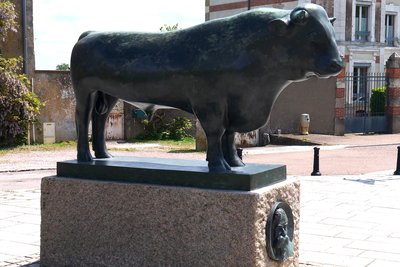
Taureau (1949) François Pompon à Saulieu - Amis saint Colomban CulturalFrançois Pompon Museum in Saulieu
The Ponpom Museum is a museum of archaeology, ethnology, history and fine arts in Saulieu. It is largely devoted to the Burgundian animal sculptor François Pompon (1855-1933) born in Saulieu on May 9, 1855. The museum is labelled Musée de France.
After attending the Dijon School of Fine Arts, he enters the marble mason's workshop at the Montparnasse cemetery in Paris. He follows the courses of the Petite École de Paris, his teachers are Aimé Millet, Pierre-Louis Rouillard. In 1890, he enters Auguste Rodin's workshop, he will meet Camille Claudel.
The work that made him known to the general public was the White Bear in 1905. His reputation as an animal sculptor began.
More information: Wikipedia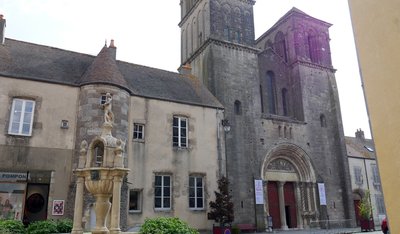
Façade de la basilique et de la fontaine Saint-Andoche à Saulieu - Amis saint Colomban TouristSaint-Andoche Church in Saulieu
The present basilica was built on the ruins of other earlier religious buildings located on the probable place of conservation of the relics of three Christian martyrs of the 2nd century, Andoche, Thyrse and Felix. The first basilica is a popular place of pilgrimage. In 447, the Bishop of Auxerre, Saint Germain, came to venerate the relics of the basilica on his way to Ravenna.
After the looting and destruction of the 9th and 10th centuries, the basilica was rebuilt during the Romanesque period and then destroyed during the Hundred Years War. It was partially rebuilt between the 15th and 18th centuries and the Romanesque capitals were preserved. In the 19th century, embellishment work was carried out on the present building.
A visit to the interior of the Basilica is a must to discover the beautiful Romanesque capitals, a prelude to your next visit to the Basilica of Vézelay.
Sarcophage de saint Andoche sous l’autel de la basilique de Saulieu - Amis saint Colomban HistoricalSaint-Andoche in Saulieu
Andoche, is a priest, disciple of Polycarp of Smyrna, who came to evangelize Gaul with the deacon Thyrsus, Saint Benign (the apostle of Burgundy) and Saint Andean. Andoche, imprisoned in Saulieu, was to suffer martyrdom because of his faith, in 177 or 178.
Description
Departure from the church of Cussy-en-Morvan, go up the rue de l'Europe, second street on the left,
- Turn left and then first right.
- At Patuet, go straight along the field at the edge of the wood.
- Stay on the main road to cross the brook of the Mill, after the brook on the left,
- Ménessaire, on the left, cross the village and turn right on the D 106H.
- On the right in front of the farm, take the dirt road on the right stay on the main road on your left, cross the two brooks.
- In Lavaux, stay on your right to avoid the village D288, Les Fourrées.
- La Croix de Cerizot straight ahead towards Guise, in Guise first street on the left continue on a dirt road.
- On the left, first dirt track, tarred road towards Moux-en-Morvan, to the right D 288, after the church on the left, track La Velle sous Moux, after the pond on the left take tarred road then dirt track, La Ruchotte, tarred road Le Boulet on the right.
- Go around the pond Neuf by the right and then the left, La Queue de l'Étang on the right, D 20, cross Alligny-en-Morvan, first on the right, street Joseph Bruley, after the wash-house on the left, stay on your right, dirt track.
- After the wood, go along a field and the first track to the left.
- Beaumont on the left, first track on the right between the farms, straight ahead, second track on the right, at the crossroads on the right.
- Moulin de Conforgien cross the brook, take the road, first dirt track on the left.
- Rue d'Island, to the left Lavault, to the right before the brook, to the left on tarred road, Ferme Bel-Air, to the right Collonchèvres, rue du Champ d'Autun, cross D 980, turn to the right, Pres-Cornets
- Rue du 11 novembre bypass the cemetery on the left, rue Danton, rue du marché on the left, on the right you arrive in front of the basilica of Saulieu.
- Departure : Church of Saint Peter and Saint Paul, 4 rue de l'Europe, 71 550 Cussy-en-Morvan
- Arrival : Saint-Andoche Basilica, 4 Place Dr Roclore, 21 210 Saulieu
- Towns crossed : Bourgogne-Franche-Comté
Altimetric profile
Transport
Report a problem or an error
If you have found an error on this page or if you have noticed any problems during your hike, please report them to us here:






